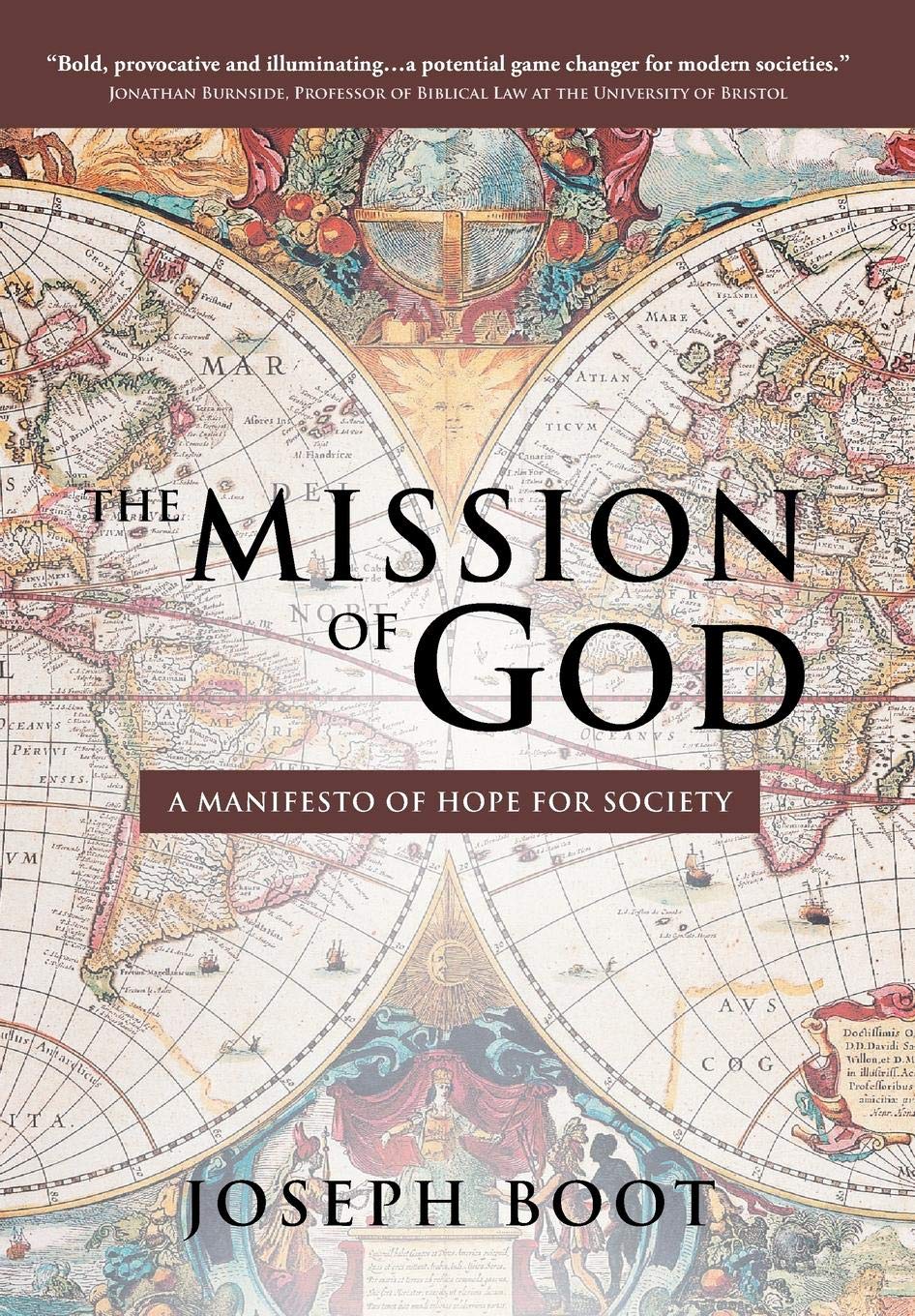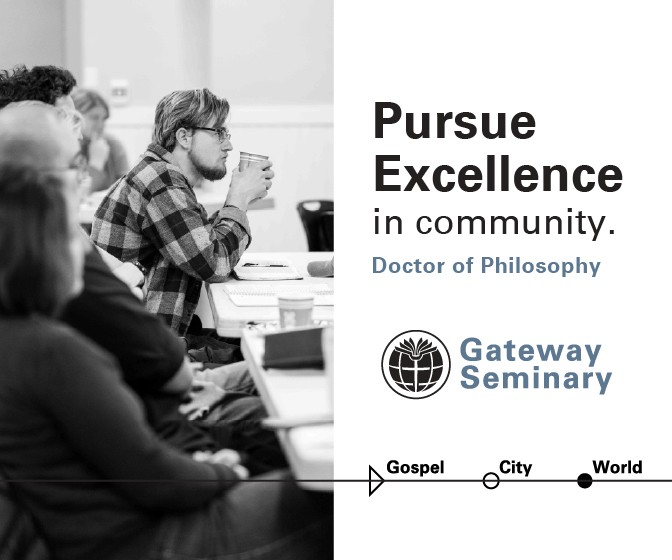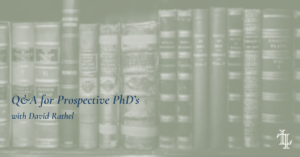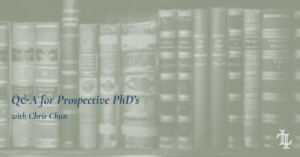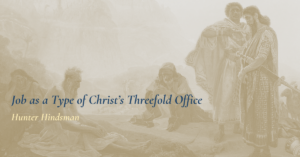Boot, Joseph. The Mission of God: A Manifesto of Hope for Society. London: Wilberforce Publications, 2016. Second edition. 673 pp. Softcover. ISBN 9780957572560. $22.77.
Joe Boot earned his doctorate from Whitefield Theological Seminary and is the author of numerous books on apologetics and cultural engagement.[1] He is the founder of the Ezra Institute for Contemporary Christianity and founding pastor of Westminster Chapel in Toronto, Ontario. His work, The Mission of God (TMG), is something of a magnum opus and has garnered much attention and a favorable reception since its publication. TMG has cast a large shadow in Ontario and beyond, leading many pastors and congregants to accept its theonomic conclusions and adopt its postmillennialism. I began reading TMG when my former pastor began his move towards theonomic postmillennialism, commenting that he believed Boot to be the foremost theologian of our day. From the perspective of this reviewer who resides in Southern Ontario, Boot’s ideas in TMG need to be critically appraised from a biblical perspective. Since its publication in 2014, no substantial review of the work (as far as I am aware) has been published.[2] The present review will succinctly summarize the main tenets of TMG followed by a critical evaluation of what I take to be serious deficiencies.
Summary
The book is divided into two parts, totaling thirteen chapters. Most chapters have a problem-solution structure: Boot presents a cultural issue then provides a biblical solution to the issue. The foundational, catch-all solution to present-day global crises is found in a recovery of biblical law for society. Such recovery is deeply embedded in the hope for a prosperous and free future. For Boot, the use and application of biblical law has tremendous historical precedence in Western civilization, particularly during the Puritan era. Evidently, the West now suffers from countless evils, and the rise of godlessness can be attributed to an abandonment of the use of God’s law.
The modern church plays a role in this abandonment. Boot observes that the church has dichotomized law and gospel, leading to a decline of biblical authority, especially the authority of the Old Testament (99). This dichotomizing can be seen in the concept of two kingdoms. He understands two-kingdom theology as a sort of cultural retreatism, an excuse for Christians to eschew involvement outside the walls of the church, thus driving an unnecessary wedge between Christians as the church and Christians in the world (381). When the church adopts any measure of natural law, according to Boot, this becomes a dire disservice, for natural law is a futile enterprise that cannot prescribe moral imperatives (261–69). As biblical law is removed from the entire scope of human affairs, decay ensues. Consequently, within judicial systems, a rise in “cheap grace” (as Boot calls it) seems almost ubiquitous, undermining true justice by softening punishments for crimes (296–99). This is also evident in education. Boot heavily questions the idea of neutrality in education, arguing that state-sanctioned pedagogy leads to deleterious consequences in society, precisely because it is ideological and pagan (442–51).
Arguably, the solution to all social evils is a recovery of biblical law in toto (25). Boot alleges that Chalcedon was the foundation of Western civilization and that the current task of the church is to see the state converted and faithfully submitting to Christ (154). The relevance of God’s law for society continues to be abiding. As leaders of the past established societies based on the pattern of Old Testament Israel, so too should the leaders of today seek to build a theocratic society (289). Only then will we see an increase in social, religious, and economic freedoms. The concluding mandate of the book is captured in a single statement: “We are therefore called unequivocally to spread the culture of Christ to all creation” (398).
Analysis
Given its length, TMG is undoubtedly a work of deep commitment and perseverance. The book exhibits the labor of a passionate Christian, who is deeply concerned about the state of the church. Boot’s observations about the decline of society and the turn away from the Scriptures are noteworthy, precisely because many churches have tended to go with the flow of secular ideologies. The imminent dangers of the public education system in Canada, with its emphases on counter-biblical sexuality and issues of identity are prominently highlighted. This is good and important, and the church would do well to keep these matters close to heart.
A key strength of TMG is the number of references to present-day issues. Boot provides numerous examples of how the English-speaking nations are abandoning biblical law in favor of “cheap grace,” which substitutes justice for ideology. Even where there is disagreement between Christians on sources of law (nature or God), there can be no question that without a transcendent lawgiver all laws are necessarily fluid. Boot rightly underscores the inescapability of God in the quest for justice.
While the book has its merits, its shortcomings are rather prominent. Chief among them is the work’s sluggish exegesis. Before diving into the specifics, it is important to note that the work lacks clear definitions. The concept of biblical law is sometimes used as “Mosaic law” and sometimes used as “law of Christ,” thus creating ambiguity. This lack of clarity also shows up in Boot’s engagement with the idea of education. We are often given examples, but the ambiguating factor emerges as readers cannot discern whether he is speaking of particular instances of an educational system or every educational system in the West—after all, these systems are largely dependent on the subcommunities within which they function. Puritanism, which features prominently in the work, also suffers from a lack of definition, as does “dualism,” a term historically loaded with heavy philosophical freight. Insofar as this review attempts to give TMG a fair hearing, the scarcity of clarity in defining terms often makes the task challenging. We turn now to some critical observations.
In the course of showing that any division between law and gospel in the NT is dualistic and artificial, Boot appeals to Titus 2:11–15 for support. He points to this Pauline text to show that the bifurcation of “the Old Testament as law and the New Testament as gospel” is artificial and false. The conclusion drawn is that “Paul makes plain here the unity of Old and New Testaments, showing that the grace of God is manifest in Christ’s work of redeeming us from ‘lawlessness,’ purifying us for his own possession” (98).
Three observations can be made. First, the passage is silent on the law. The only occurrence of “law” in Titus is at 3:9, where Paul enjoins Titus to avoid quarrels about the law. Second, the passage highlights the present age as one lived in anticipation of the second coming, not an earthly Christian golden age. The grace that appeared (2:11) trains believers to renounce spiritual vices and to live “self-controlled, upright, and godly lives in the present age” (v. 12). Boot fails to take stock of something very clear and possibly antithetical to his theological position: the present age is characterized by “waiting for our blessed hope, the appearing of the glory of our great God and Saviour Jesus Christ.” Contextually and theologically, Jesus Christ’s appearing is physical and serves as the necessary and sufficient source of our hope in the present age. Boot does not parse out the meaning of “hope” nor his understanding of “appearing.” Furthermore, his exclusive focus on the present aspect of the passage is at the expense of the future aspect of the passage, and this leads to a dilemma. Either take the future blessed hope and the appearing of Jesus as the millennial golden age, thus spiritualizing the second coming (“appearing”) of Jesus Christ or accept that waiting for the second coming is the motivating factor to live godly lives, thereby undermining the chief postmillennial thesis of TMG. Since the goal of TMG is to reform society, Boot’s reading of Titus 2:11–15 appears to suggest that Christ’s second coming will not be physical but, rather, spiritual. If I understand Boot correctly, and if the subtitle of TMG serves as an indicator (A Manifesto of Hope for Society), the idea of hope is grounded in law-keeping, not in the future anticipation of Christ’s bodily return. Third, and perhaps most embarrassingly for Boot, is his unambiguous misreading of the passage. He observes that the redeemed people “are zealous for the good works” (v. 14). Certainly, he is correct, for the text says exactly that. But his full observation reads, “are zealous for the good works and the life of self-control prescribed in God’s law” (99, emphasis mine). The mention of “law” was introduced in a rather back-door manner, manipulating the passage so that it appears to support Boot’s position.
Another example turns up in the chapter on Christian education. While Boot aptly shows the weaknesses of public education as a system built on increasingly godless ideologies, his attempt to defend a biblical mandate of education is short of successful. Where biblical references are found, these are not explained and can often be interpreted in other ways. His argument in defense of a Christian curriculum is largely dependent on one text: Matthew 28:18–20. This is the only text Boot unpacks, claiming that the authority given to Christ is now translated into a mandate to educate (452).
I suggest this is a misreading of the text and an example of eisegesis. The Great Commission mandate is to make disciples of all nations. This is the only imperative in the passage. The way disciples are made is through baptizing and teaching. Presumably, the goal of the commission is to make believers (i.e., disciples) through the proclamation of the gospel, which consequently leads to the act of baptism and the work of teaching. But Boot understands this differently, or, minimally, he sees something else. His understanding is that “teaching” includes a mandate to formally educate from a biblical worldview by establishing Christian curricula. In other words, the Great Commission’s aspect of teaching includes both spiritual matters and, among other subjects, biology. However, there is nothing in the context of the passage to buttress such an imperative. At best, Boot’s conclusion is a possible implication, but he failed even to make an argument for this possibility—that is, the implication was assumed.
Moreover, Boot points to Matthew 18:6–7, claiming that false education of children is something Jesus condemns. Of course, Boot rightly acknowledges that the text is referring to believers, and that “children,” in the context, refers to Christ’s regenerate followers. Nonetheless, he claims, “it seems clear that he [i.e., Jesus] specifically has vulnerable children in mind when he brings a child into their midst,” concluding that subjecting children to non-Christian curricula is tantamount to “laying a serious stumbling block in front of our children” (454). Whether this was part of the original intent of Matthew, the reader can decide.
Boot suggests, “[a] full-orbed [i.e., inclusive of all subject matters] Christian education is the logical outworking of biblical faith in obedience to the command to raise our children in the fear and admonition of the Lord” (429). This claim garnered the most biblical support, though only by way of parenthetical references (that is to say, no exegesis). The four passages are Exodus 13:2; 34:19; Psalm 24:1–2; 127:3. I encourage readers to look up these references and decide for themselves whether they support his claim or whether they are simple proof-texts.
An important feature of TMG’s thesis is that the whole earth is part of the mission of God. This goes beyond the church and includes a call to influence institutions and care for the environment. This is referred to as “the cultural mandate” (71–75). This cultural mandate, explains Boot, includes three land grants. The first land grant was Eden, which was subsequently lost. The second was Canaan. This land too was lost through exile. The third is the present land grant of the whole earth to believers. This land grant, according to Boot, “is made clear in Romans 4:13, Ephesians 6:3, Mark 10:29–30, and Matthew 5:5; 28:18–20” (73). However, even a preliminary reading of these passages indicates that none of them can plausibly support the conclusion that the earth is a land grant to believers—all are disconnected proof-texts.
In addition to the general engagement with texts of Scripture, some arguments tend to rest on dubious lexical grounds. Boot draws conclusions about the verb plēroō from lexicographical evidence, but he does not cite any lexicon and does not engage with the verb in any context where it occurs. Yet he confidently concludes that plēroō implies that Christ has “come to implement and put into force his law” (96). Likewise, in arguing for the believer’s purpose “to discipline and organize nations into covenant-obeying peoples,” Boot claims that the call to discipline is contained in the Great Commission’s mandate to “teach.” This, he suggests, is taken from the fact that “the word teach in the Greek language (mathatos) means literally ‘disciple’” (376, emphasis original). However, this is a very simplistic approach to lexicography. Words mean something in the context in which they are used. Perhaps most challenging to Boot is the embarrassing fact that mathatos never occurs in the NT in any form whatsoever, whether it be its lexical (dictionary) form or derived forms. (The transliterated word mathatos does occur in non-NT literature; perhaps he meant μαθητής [mathētēs]).
The book also demonstrates a great inability by the author to provide relevant evidence to buttress positions and is woefully lacking in primary sources, being largely dependent on secondary works. Boot’s analysis of justice illustrates this well. Several pages are dedicated to refuting Tim Keller. However, no other author is cited—Keller is the sole punching bag. Boot also discusses and critiques the work of Gustavo Gutierrez, but never quotes him directly. The same applies to his engagement with Ronald Sider. Sider apparently manipulates the Exodus story in the attempt to draw out a sort of liberation theology, and his “interpretation strains all credibility” (228). Likewise, in the engagement with Meredith Kline’s “intrusion ethics,” Boot concludes that Kline’s eschatology is “problematic” and “convincingly refuted by Greg Bahnsen” (321–22). Kline is not referenced anywhere in the discussion.
Though many more examples can be proffered as evidence of the book’s poor research methods, a final illustration is in order. One of the arguments in favor of a biblical education mandate emerges from an observation of early Jewish history. Boot explains that synagogues in the first century were places where parents sent their children to learn the Scripture and other subjects. This sort of education was made compulsory. Children studied, among other things, the Mishnah and the Talmud (426). On top of providing no historical source for these claims, Boot is grossly anachronistic. The Talmud, a monumental expansion of and commentary on the Mishnah did not exist until several centuries after the destruction of the temple. Even the Mishnah was not codified until the third century A.D., and its oral existence in the first century is a matter of significant debate.
Besides lacking primary source evidence, the work appears to have significant theological deficiencies. Perhaps most evident is a manifestly over-realized eschatology. Throughout the work, Boot refers to past societies in the West, drawing a proportionality relationship between adherence to biblical law and prosperity. The book makes little to no mention of a future kingdom after the second coming of Christ and puts forth no effort to distinguish between the heavenly and earthly, a distinction so prominent throughout the Scriptures. What is more, OT promises about land, for example, are reappropriated and applied a priori to the church as a physical organism—that is to say, the promises are interpreted literally, such that the kingdom of God becomes a matter of quantification. This point is clearly manifested in the book’s examination of the parable of the mustard seed. Boot likens the Christian states of being to the mustard seed, which “grows and creates, as it has done wherever it has been in history, a type of civilization” (398). The kingdom of God’s telos is strictly earthly and, as Boot seems to suggest, will come to full fruition before the second coming of Jesus. Practically, then, if this understanding of the kingdom is applied to Christianity in, say, present-day China, the conclusion must be that the kingdom there is rather weak.
In relation to the general understanding of the kingdom, Boot’s discussion of prosperity also hints at an over-realized eschatology. He claims that a poverty-free and debt-free society can happen, if and only if God’s law is obeyed. There are no biblical references in the argument, only a partial quotation from James 1:25 (251). Boot’s argument is simple: following God’s law will lead to the eradication of poverty and debt. No space is even considered for an engagement with Jesus’ words in Matthew 26:11. The troublesome aspect of this claim is that it reveals a fundamental misunderstanding of eschatology. While there is a day coming when all tears will be wiped away, and poverty will effectively be non-existent, that day will follow the second coming of Christ. Contrary to this, Boot seems to think that a poverty-free society can be realized on this side of eternity.
Further to this point, the issue of prosperity is rather important. While the New Testament seems to be silent with respect to physical blessing as a consequence of obedience, the Old Testament is quite unequivocal in expressing that reality. Surely, we must ask why the NT is silent. But Boot does not engage that question. Rather, he assumes the OT teaching, endorsing a perspective quite similar to the prosperity gospel—if a faithful farmer is experiencing a bad season, it may likely be because of his disobedience. Thus, if we “want to see human flourishing in the land and blessing on our agriculture, cattle, wilderness and animal kingdoms,” notes Boot, “we must obey God’s law” (251). Boot espouses salvation by faith alone; however, it seems that he is advancing an argument for blessing based on works, rather than faith, and that membership in the kingdom requires law-keeping, a perspective quite like covenantal nomism.
Another point of contention is Boot’s engagement with Philippians 3:21. He maintains that this verse supports the theonomic, postmillennial claim that Christ is to be King of the nations. Of course, Boot’s understanding is that Christ will be king of all nations as a king who is not physically present. Christ will rule the earth, such that all will submit to him before his second coming. But Philippians 3:21 can hardly support this view—unless, of course, one takes the verse out of context. Boot only looks at the second part of the verse: “by the power that enables him [i.e. Jesus] even to subject all things to himself.” Is this a subjection in the present age or in the age to come? Here’s the verse in its context: “But our citizenship is in heaven, and from it we await a Savior, the Lord Jesus Christ, who will transform our lowly body to be like his glorious body, by the power that enables him even to subject all things to himself” (vv. 20-21). The context makes the time of Christ’s subjection of all things to himself either inconclusive or in the future age, when the awaited Savior appears, and we receive our glorified bodies. Most certainly, then, the verse cannot be adduced as evidence in favor of a postmillennial global Christian dominion.
Perhaps the most questionable feature of TMG is the general approach to biblical law. Historical examples of biblical law as a basis of government far outweigh any discussion from the Scripture. In developing his position on the source of law (God or nature), Boot rejects natural theology and natural law, arguing that it is a form of self-law, which stands in absolute opposition to God’s law (261–67). He does not engage with any position that defends natural theology/law (with the possible exception of one article by Michael Horton on two-kingdom theology), and no latitude is given for the role of natural law at all. Thomistic thought is rejected a priori as pagan ideology (265). Only four Bible references are given to counter natural law: Romans 1:24; 1:29–32; 2; 2:14–15. But these merely occur parenthetically, and no exegetical argument is put forward. Furthermore, in approaching the question of Paul and the law, again, there is no exegetical engagement (100–02). The best one finds are sporadic, free-standing verses. No discussion of Paul’s understanding of the law in Galatians is found anywhere in the book—all Galatians references related to the law appear in TMG in only one paragraph. What is more, Boot’s arguments against law-gospel dualism seems to be at odds with Galatians 4:21–31. Yet there is no discussion of this text.
Another observation relates to the book’s hermeneutic. While he appears to be quite critical of dispensationalism, contending that its eschatology is a Marcionite heresy (83), TMG appears to operate on a similar hermeneutical wavelength as dispensationalism. In general, a dispensational hermeneutic understands the promises of the OT to be fulfilled literally. Dispensationalists generally look at passages related to land in the OT and conclude that a future fulfillment awaits these promises before the second coming of Christ. In like manner, Boot seems to apply the same hermeneutical method. He understands the promise of land to be fulfilled in a material way before the return of Christ. This is especially highlighted in his discussion of the three land grants (73). For Boot, the kingdom is a matter of physical expansion, and the kingdom’s expansion can be quantified by, among other things, the application and use of biblical law at the institutional level. Thus, to the degree that biblical laws are used in the courts, for example, is the degree that the kingdom of God is manifested.
Barring these observations, TMG also contains many errors of spelling, grammar, typography, and citation. Titles of books in the endnotes are inconsistent; some are italicized, others are in quotation marks, and the same works appear capitalized and then lowercased. Names are misspelled (e.g., J. S. Elliot, Schofield, Mathew). Semicolons occur very inconsistently, often used where a comma should be, thus creating incomplete sentences. The use of commas in lists is conflicting. Some lists employ the Oxford comma, but the majority do not. Quotation marks are sometimes absent (e.g., 201) and sometimes occur where they should not (e.g., block quotation on 503). There are multiple mistakes in Bible references, and, while the natural manner of presenting parenthetical lists of Bible references is linear, i.e., from Genesis to Revelation, the book’s practice is erratic (see, e.g., 151).
When engaging with proponents of an opposing position, the work often employs genetic and ad hominem fallacies. In his discourse on utopia, Boot begins with a discussion of Jean Jacques Rousseau, whom he understands as the predecessor of Marxism. He does not reference Rousseau at all yet concludes that Rousseau is wrong because he is “odious,” a “professional hypocrite,” and “debauched narcissist” whose character is “infantile and vile” (157). Meredith Kline is refuted as “fanciful and excessively dependent on endless typologies,” adopting a position that is “highly problematic” (321–22). Tim Keller is “confused,” having produced a “confusing work” that “ties himself in knots.” Boot claims to be discouraged because Keller “seems to have become overanxious to please the current culture and sound trendy” (204). Boot’s response to Generous Justice includes the following observations: “contorted logic,” “muddled caveats,” and “anti-biblical.” He further concludes that “Keller is simply talking nonsense” and that he “should simply know better” (213). In like manner, Boot attacks Horton for his two-kingdom perspective. Boot refers to two-kingdom adherents as “cowards” and “cultural retreatists” (381). Advocates of two kingdoms are indicted with “treason to the king of righteousness” because of “a doomed attempt to wed idolatry with true worship, righteousness with lawlessness” (384). These charges are laid within the first six pages of the two-kingdom critique, yet Horton is quoted only once. Carl Trueman also receives unjust criticism, being charged with “English snobbery” and forsaking objective historiography with “a visceral emotional outburst” (644 n. 1).
On the whole, TMG seems to be the product of someone who has legitimate concerns about the state of society. Unfortunately, the solutions to these concerns are not presented carefully, either from the Bible or from history. The number of errors is so significant that it should alarm readers to know that this book is in its second edition. Given its influence, pastors should read this work. A word of caution is in order, however. While the book may certainly resonate with many conservatives (like this reviewer) who see the West’s social values as increasingly decaying, its rhetoric may overshadow its scholarly integrity. What we see in TMG is a hermeneutical method that oddly lines up with post-modernism, where historical and cultural observations are added to the process of text interpretation. Pastors seeking to be faithful in the interpretation of Scripture cannot allow culture to drive the process of exegesis.
Editors Note: The London Lyceum publishes a range of original pieces and book reviews from various faith traditions and viewpoints. It is not the mission of the London Lyceum to always publish work that agrees with our confession of faith. Therefore, the thoughts within the articles and reviews may or may not reflect our confessional commitments and are the opinions of the author alone. Rather, we seek to generate thinking and foster an intellectual culture of charity, curiosity, critical thinking, and cheerful confessionalism.
[1] Whitefield is an unaccredited school in Lakeland, Florida
[2] As a note, there is another substantial review pending publication. It will be linked to herein once available.
Author
-

Tom is a PhD student at Midwestern Baptist Theological Seminary writing a dissertation on Paul’s understanding of the kingdom. He is the resident theologian at Hespeler Baptist Church in Cambridge, Ontario. In addition to being a student and serving his church, Tom oversees Diadem Construction Ltd., a growing business operating in the Southern Ontario region. He and his wife Samantha have three young children.
View all postsRecent Posts
